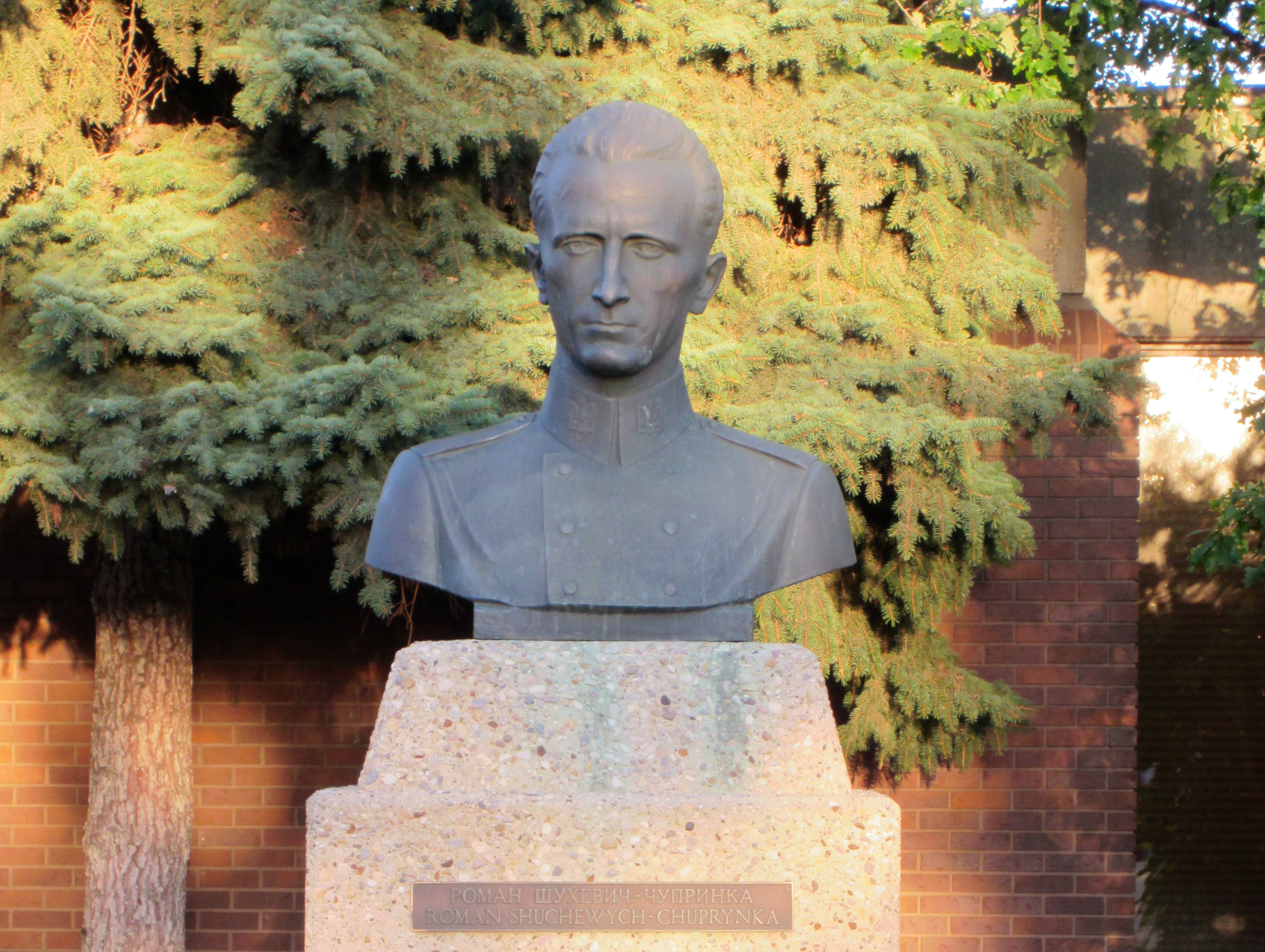
The monument to Roman Shukhevych, commander of the Ukrainian Insurgent Army from 1943 until his death in 1950, has stood at the entrance of the Ukrainian Youth Unity Complex in North Edmonton, Alberta, since mid-1970s. Shukhevych is lionized by some for his fight for Ukrainian independence against Poland, the Soviet Union and later Germany. But critics of the monument say it glorifies a Nazi henchman who sided with Germany in hopes of winning independence for Ukraine. (Photo courtesy of John-Paul Himka)
A Canadian monument to a hero of an anti-Soviet nationalist uprising in Ukraine is raising questions about the manipulation of historical memory for political purposes.
Critics of the monument say Roman Shukhevych was also a ruthless Nazi henchman and honouring him plays into the hands of the Kremlin propaganda machine that seeks to delegitimize the very idea of Ukrainian statehood.
The bronze bust of Shukhevych, one of the leaders of the Organization of Ukrainian Nationalists (OUN) and the commander of the Ukrainian Insurgent Army (known under its Ukrainian acronym UPA) during WWII and immediately after, has stood quietly at the entrance of the Ukrainian Youth Unity Complex in North Edmonton, Alberta, for 45 years.
Shukhevych’s stern gaze has greeted generations of Ukrainian-Canadians who came to the centre for various community activities, oblivious of the national hero’s messy wartime record of mass murder and ethnic cleansing.
But a series of tweets by the Russian embassy in Ottawa last October, decrying the presence of Nazi monuments in Canada has put the wartime record of the OUN and UPA and one of its most famous and controversial leaders under public scrutiny.
The tweets focussed on three monuments: the bust to Shukhevych and two monuments to the veterans of the 14th Waffen SS Galicia Division that was renamed into the 1st Ukrainian Division shortly before the end of WWII. One of these monuments is located at the St. Michael’s cemetery in Edmonton, the other is in Oakville, Ontario.
Ukrainian-Canadian historian John-Paul Himka, believes the Russian embassy tweets are part of a propaganda campaign by the Kremlin.
“They have an interest in these matters because they are trying to present Ukraine as a fascist regime and as a Nazi coup, so that fits into their agenda and they like to create division and chaos in democratic countries,” says Himka.
But it doesn’t mean that some of the Russian allegations are untrue, Himka says.
“They look for things that they can use,” Himka says, adding that he is very troubled by attempts by some Ukrainian-Canadian leaders and organizations to whitewash Shukhevych’s wartime record and glorify his exploits.
Lionized by some in the Ukrainian Canadian community as a brilliant guerilla commander who led the largest insurgency in Europe against Stalin, Shukhevych is considered a war criminal by Jews and Poles for his alleged role in the Holocaust and an ethnic cleansing campaign against the Polish minority in Western Ukraine.
A multicultural paradox
Per Rudling, an associate professor of history at Lund University in Sweden, says he became aware of the Shukhevych monument 15 years ago while completing his PhD at the University of Alberta.
“I had been working on Ukrainian nationalist movement, Ukrainian-Polish and Ukrainian-Jewish relations during WWII, so … I found it a little bit puzzling the first time I saw it,” Rudling says.
He was even more perplexed when he found out that the monument was partly funded by Canadian taxpayers through programs designed to promote multiculturalism in Canada.
A far right movement
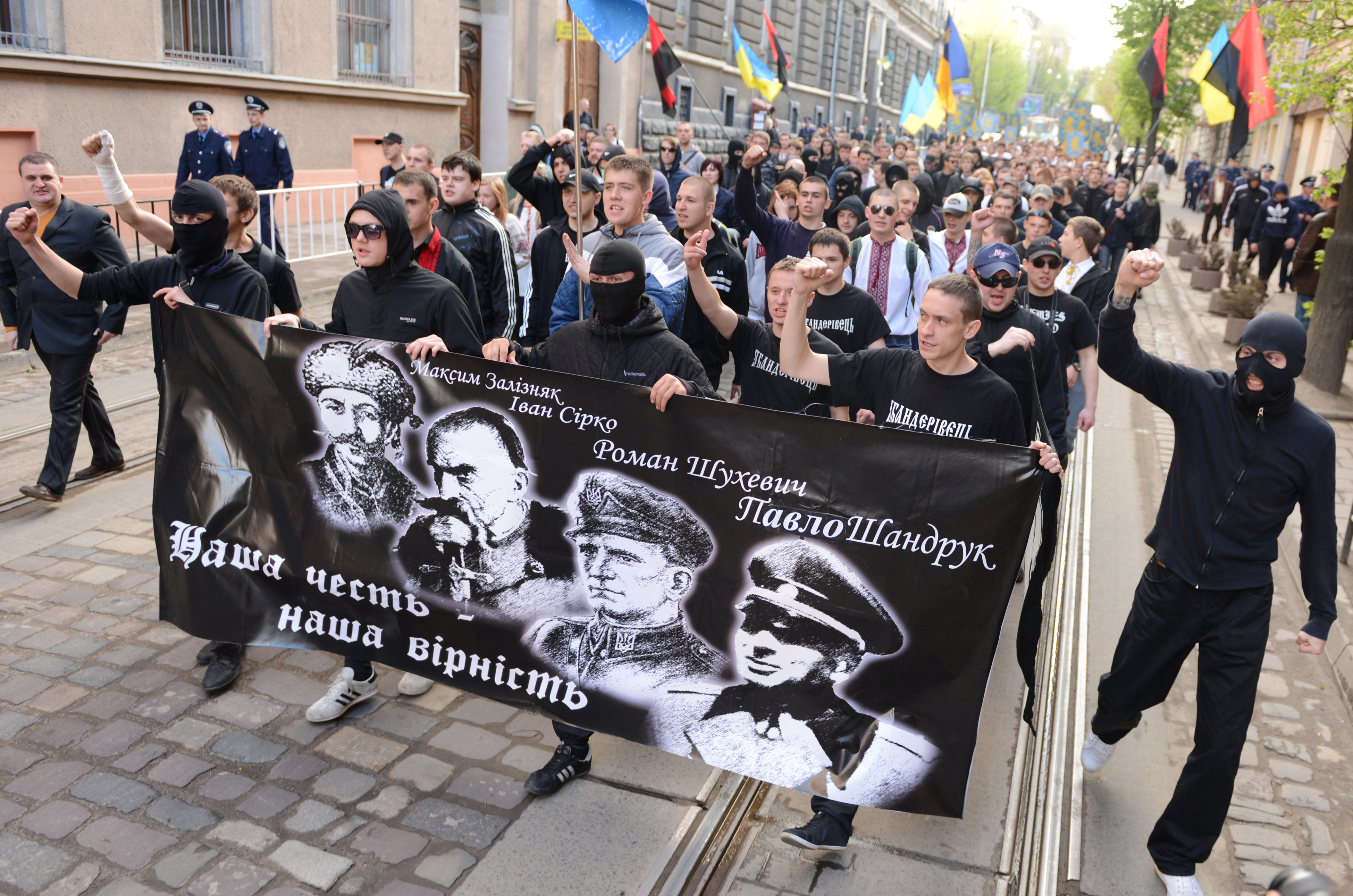
Ukrainian ultra-nationalists, carrying a banner with a portrait of Ukrainian Insurgent Army (UPA) Roman Shukhevych (second from the right), march in the centre of the western city of Lviv on April 28, 2013. The march commemorated the 70th anniversary of 14th Waffen SS Galicia Division made up mostly of Ukrainian volunteers. (YURIY DYACHYSHYN/AFP/Getty Images)
The OUN was founded in 1929 by Ukrainian war veterans frustrated by their failure to establish an independent state after the collapse of the Russian Empire and the Bolshevik revolution in 1917–1920, following which Ukrainians found themselves divided between four states: the USSR, Poland, Czechoslovakia, and Romania.
Formed out of a merger of radical nationalist and fascist groups, such as the Ukrainian National Association, the Union of Ukrainian Fascists, and the Union for the Liberation of Ukraine, the OUN became the dominant political movement of the Ukrainian far right, Rudling writes in a research paper entitled The OUN, the UPA and the Holocaust: A Study in the Manufacturing of Historical Myths.
The organization resorted to terror to achieve its political goals.
Terrorist beginnings
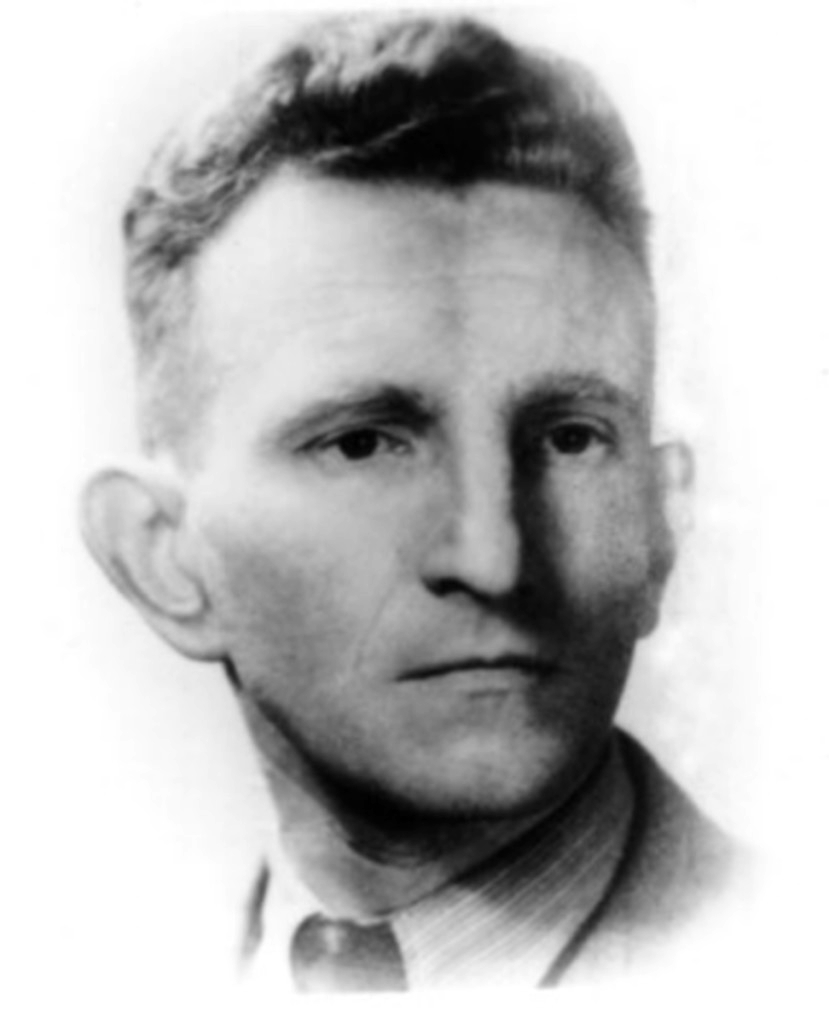
Undated photo of Roman Shukhevych (CC BY-SA 4.0)
Shukhevych committed his first political assassination at the age of 19 in 1926, killing Polish school curator Stanisław Sobiński in Lviv in retaliation for his role in implementing language policies of the Polish government that were designed to assimilate Poland’s restless Ukrainian minority.
In 1934, Shukhevych was arrested for his involvement in the murder of Polish Interior Minister Bronisław Pieracki.
Shukhevych spent two and a half years in prison, where he was allegedly tortured by the Polish authorities, Rudling writes.
In January, 1938, Shukhevych crossed the border from Poland to Czechoslovakia, setting up a new political base in the Carpathian Ukraine.
According to Rudling, in the spring and summer of that year, Shukhevych received officer’s training at a German military academy in Munich.
Caught between Moscow and Berlin
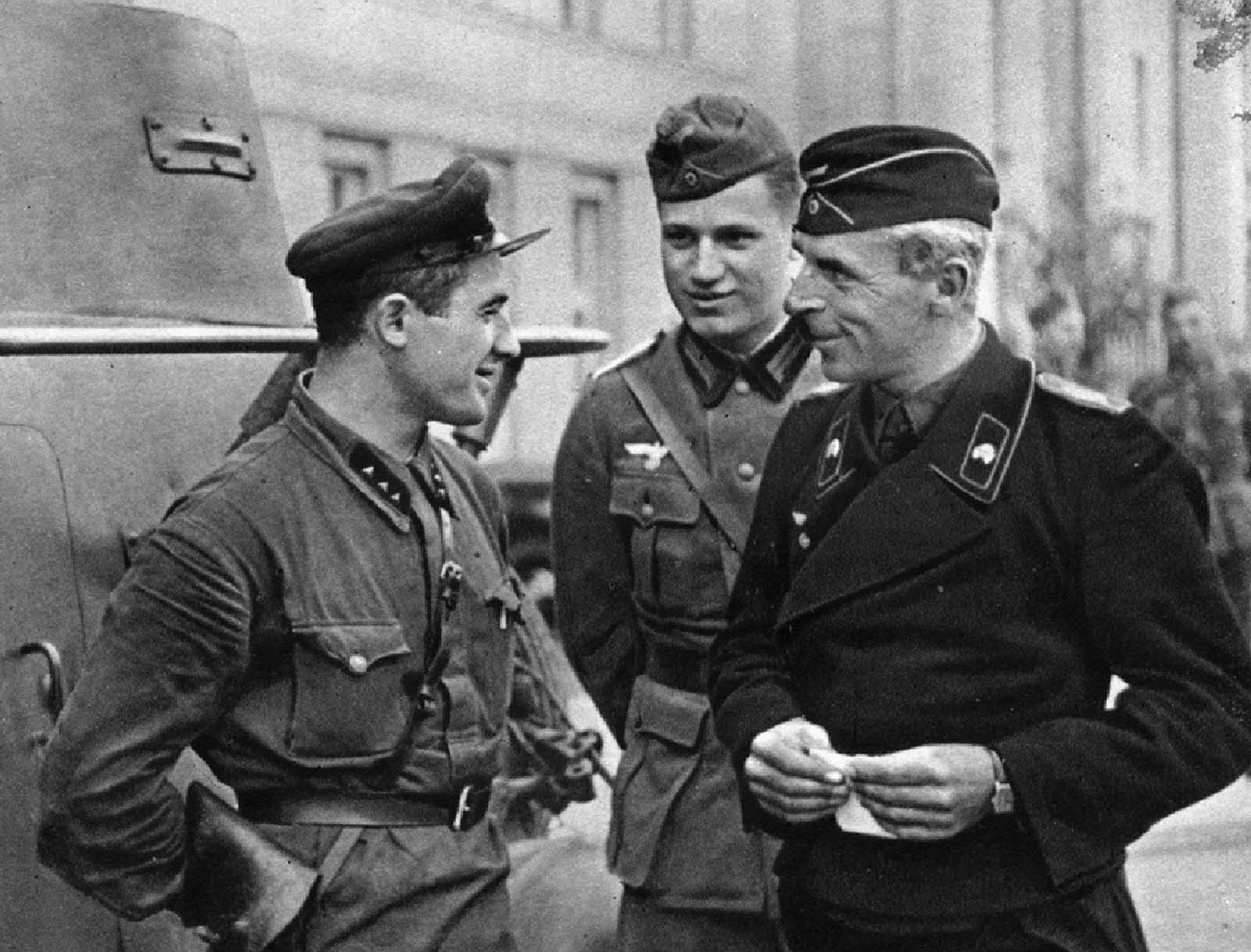
Soviet and German officers are having a friendly conversation in the newly captured Polish city of Brest, September 1939. This photo was taken during a joint Soviet – German military parade in Brest, Sep. 22, 1939.
In 1939, as Adolf Hitler and Joseph Stalin partitioned Poland, many leading OUN members gathered in the German-occupied part of Poland, the so-called General Government.
The Soviet purges targeting Ukrainian nationalist leaders and intellectuals further radicalized the OUN.
With the moderate nationalist leaders either executed or exiled to GULAG camps all over the Soviet Union, the OUN, thanks to its robust underground structure, was the only Ukrainian nationalist organization that survived more or less intact, says Dominique Arel, professor at University of Ottawa, where he holds the Chair of Ukrainian Studies.
“The Polish underground was gone, the Zionist underground was gone,” Arel says. “The OUN was the only one left standing.”
By 1941 the OUN had split into two factions: a more radical wing comprised of younger militants and named after its leader, Stepan Bandera, the OUN(b), and a more conservative faction made up of older veterans, the OUN(m), led by Andrii Melnyk.
“Both were totalitarian, anti-Semitic, and fascist,” Rudling writes. “But there was a difference in tactics: the OUN(m), the smaller of the two wings, was more cautious and stayed loyal to Nazi Germany throughout the war, whereas the OUN(b) took a more independent line vis-à-vis Nazi Germany.”
Shukhevych became one of the key organizers of the OUN (b) faction.
A German commando
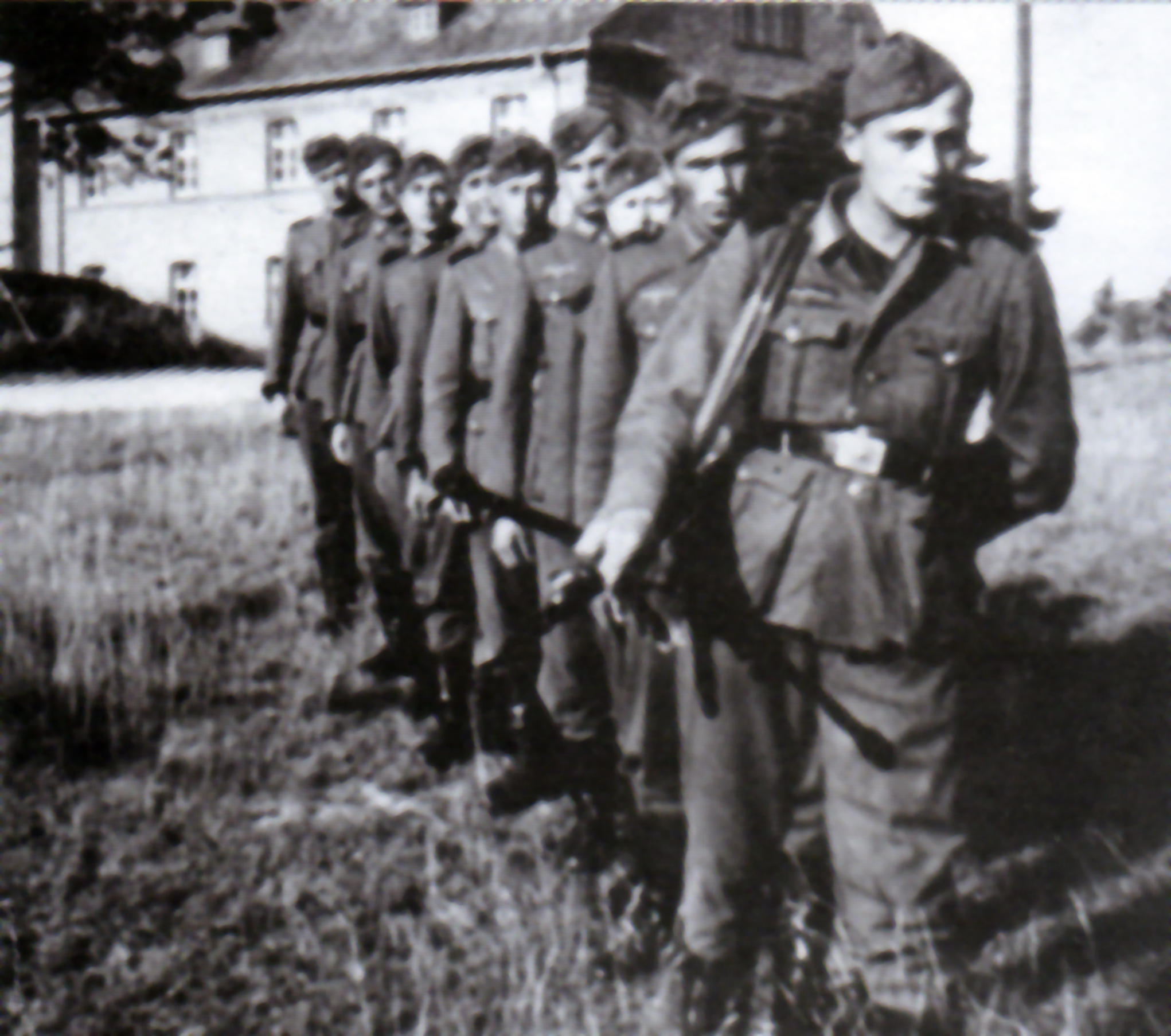
The Ukrainian volunteers of the Nachtigall batallion were outfitted in German uniforms and weapons.
In the late spring and summer of 1940, Shukhevych joined over 120 other Ukrainian nationalists for training at a secret espionage school run by the German military intelligence, Abwehr, in Zakopane, in German-occupied southern Poland, Rudling says.
With planning for the invasion of the Soviet Union entering its final stages, Abwehr set up two small Ukrainian units: Sonderformation Nachtigall and Organisation Roland.
The Nachtigall battalion, which consisted mostly of Ukrainian nationalists, was formed in Krakow in March of 1941 and its members received their training at a German boot camp in Neuhammer, Silesia, in present-day western Poland.
The Ukrainian volunteers were outfitted in German uniforms and weapons, and were attached to the 1st Battalion of the Regiment Brandenburg-800, Nazi Germany’s elite special forces unit, trained to work behind the enemy lines, securing strategic infrastructure such as bridges and oil facilities, carrying out sabotage and assassinations.
In the rank of Hauptmann (Capt.) Shukhevych became the highest-ranking Ukrainian officer in the Nachtigall battalion, where he was shadowed by German liaison officer Theodore Oberländer, who later became a minister in the post-war cabinet of West German Chancellor Konrad Adenauer.
The Nachtigall battalion took part in the German invasion of the Soviet Union on June 22, 1941 and marched into Lviv on June 30, 1941.
Lviv pogrom
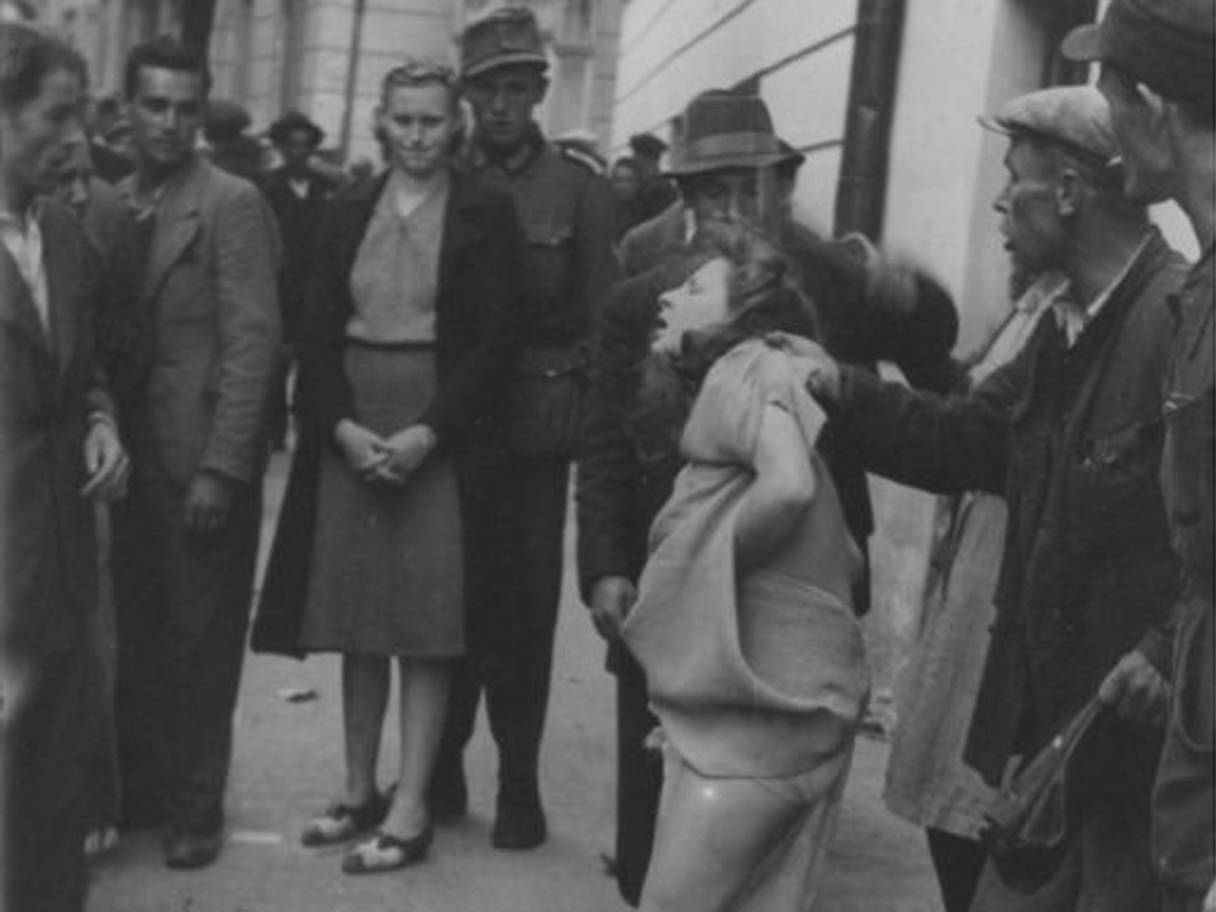
A woman is being attacked during the Jewish pogrom in Lviv in July 1941.
During the hurried retreat from the rapidly advancing German army, Stalin’s henchman Lavrenty Beria ordered the execution of thousands of detainees held in prisons across Western Ukraine, rather than have them freed by the Germans and join the anti-Soviet forces.
The massacre of thousands of Ukrainian prisoners, including Shukhevych’s brother further inflamed the anti-Soviet and anti-Jewish sentiments in Western Ukraine, where a strong undercurrent of anti-Semitism existed prior to WWII.
A bloody Jewish pogrom began in Lviv as the news of the prison massacre spread on July 1, 1941.
However, the accusation that Nachtigall organized and carried out the the pogrom was a Soviet fabrication designed to undermine the Adenauer government, using Oberländer’s wartime connection to the battalion, says Himka.
Although historians are divided on the exact role of the Nachtigall battalion in the Lviv pogrom, most have no doubt that the battalion took part in the murders of thousands of Jews on its march from Lviv to Vinnitsa, about 430 kilometres east of Lviv.
Aborted independence
On June 30, the Bandera faction of the OUN, hoping to emulate the example of neighbouring Slovakia and its Balkan ally, the Ustaša Croatia, declared independence while also pledging allegiance to Nazi Germany.
But the Germans had no intention of creating a Ukrainian state in a zone of their vital strategic interests and clamped down on the OUN(b) leadership.
The Nachtigall battalion was dissolved and disarmed. It was reconstituted into Schutzmannshaft battalion 201, an auxiliary police unit.
After receiving some additional training, much to the chagrin of its Ukrainian volunteers the battalion was transferred further north to neighbouring Belarus to fight Soviet partisans.
Apprenticeship in mass murder
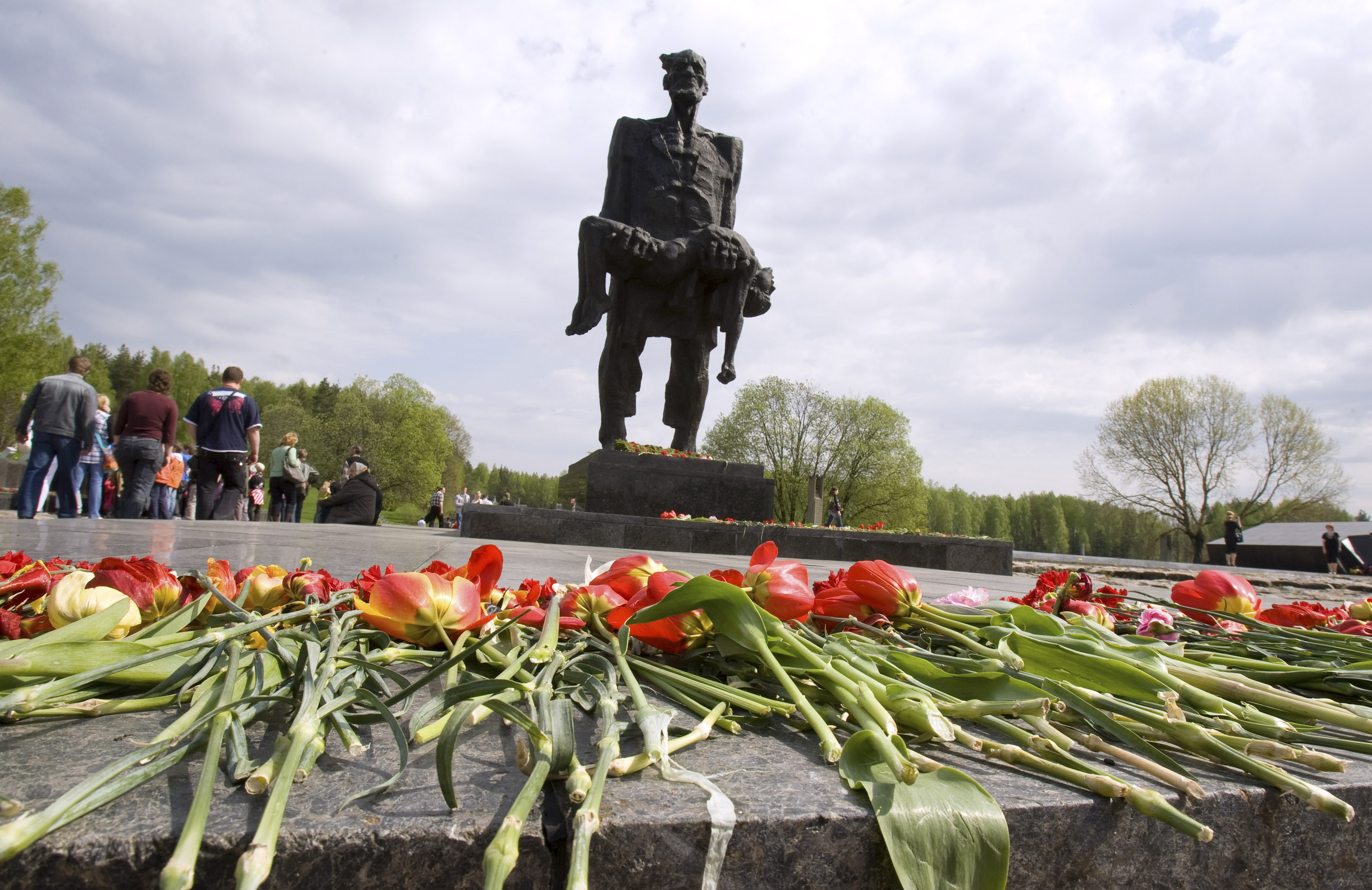
People visit a World War II memorial in the former village of Khatyn, some 60 km (37 miles) northeast of Minsk, May 8, 2010. Historians say Nazi troops killed 149 villagers, most of them children and women, and burned down their houses. The village was never restored. (Vasily Fedosenko/REUTERS)
While much of the records of Shukhevych’s time in Belarus were destroyed or lost, the analysis of the casualty reports allows researchers to conclude that the Schutzmannshaft 201 wasn’t just fighting Soviet partisans, but also took part in reprisals against unarmed civilians, says Rudling.
For each casualty that the battalion suffered there were about 40 locals killed, according to research by Rudling.
“Either they were the world’s best soldiers or they were killing a lot of civilians, probably the latter,” says Himka.
However, doing the Nazis’ dirty work in Belarus demoralized the unit and in 1943 many of them, including Shukhevych returned to Ukraine where they formed the core of the new insurgent army, the UPA, organized by the Bandera wing of the OUN.
The skills and the lessons learned in Belarus were then applied with ruthless efficiency to the Polish population of Western Ukraine when Shukhevych was made the supreme commander of the UPA in August of 1943.
“They fought for independent Ukraine but they also went after and killed between 60,000 and 100,000 ethnic Poles in a mass campaign of ethnic cleansing under Shukhevych’s leadership,” says Rudling.
The UPA was also involved in the murder of thousands of Jews who had survived the initial wave of the Holocaust and were hiding in the forests of Western Ukraine, says Rudling.
Himka says his research shows that in the winter of 1943-44 the UPA lured the surviving Jews out of the woods and then murdered them.
“And then ethnic cleansing operation also engulfed other minorities,” says Himka. “They killed Czechs, they killed Armenians, they killed ethnic Germans.”
The idea was to create an ethnically homogeneous country, he says.
The making of a national hero
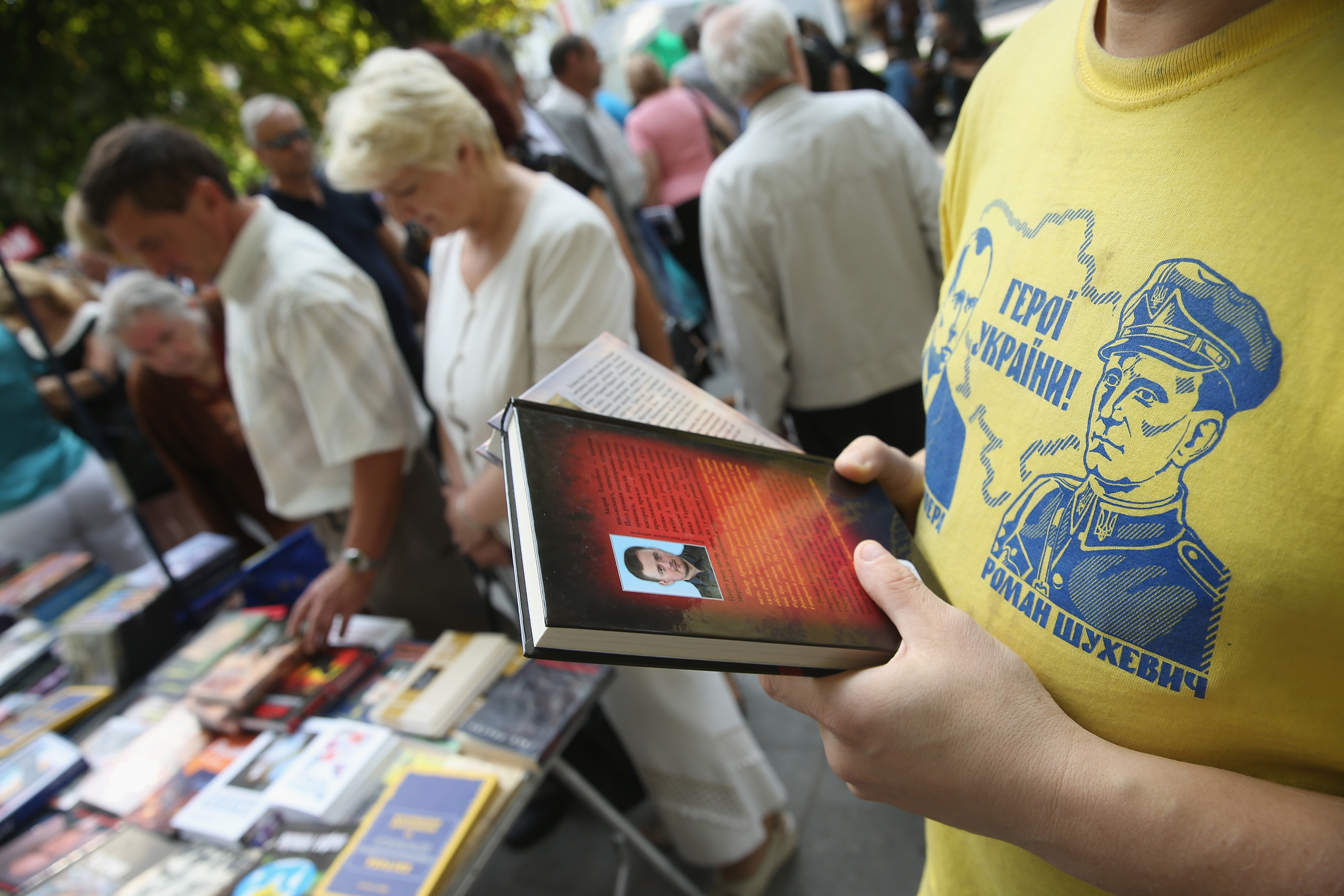
A man at a stall selling “Ukrainian patriotic literature” wears a t-shirt showing historical Ukrainian nationalist militant figures Stepan Bandera and Roman Shukhevych under the slogan “Heroes of Ukraine!” on September 14, 2014 in Lviv, Ukraine. The ongoing war in eastern Ukraine between pro-Russian separatists and the Ukrainian army has influenced popular culture in Ukraine and encouraged Ukrainian nationalists. Bandera and Shukhevych led a violent uprising against Polish administration of western Ukraine in the 1920s and sided with the Nazis during World War II in their attempt to win Ukrainian independence. (Sean Gallup/Getty Images)
However, what Shukhevych is remembered for in Western Ukraine and among Ukrainian-Canadians who immigrated to Canada after WWII from that part of the country is his insurgency against the Soviet forces, says Rudling.
In 1945, the war didn’t end in Western Ukraine, there was a very long-lasting and tenacious insurgency against the Soviets.
“Shukhevych is remembered for having fought the Soviets and having led the resistance against the Soviets until he was killed or committed suicide in March of 1950,” says Rudling. “So he is remembered very differently: Jewish survivors and Poles remember him quite-quite differently than Ukrainian nationalists in Canada do.”
The Soviet security services carried out a very brutal counterinsurgency campaign with casualties among the Ukrainian population climbing to at least 100,000 people and mass arrests and deportations of more than 200,000 nationalist sympathisers to Siberia, almost all of them from the Galicia region, says Arel.
“The Soviets used the principle of collective responsibility,” says Arel. “In order to defeat the insurgency, they targeted their families.”
For the Western Ukrainian society it was an enormously traumatic event.
“But for the Ukrainian national narrative this is the one time when you had massive resistance against Russian occupation,” says Arel.
Competing narratives and quest for legitimacy
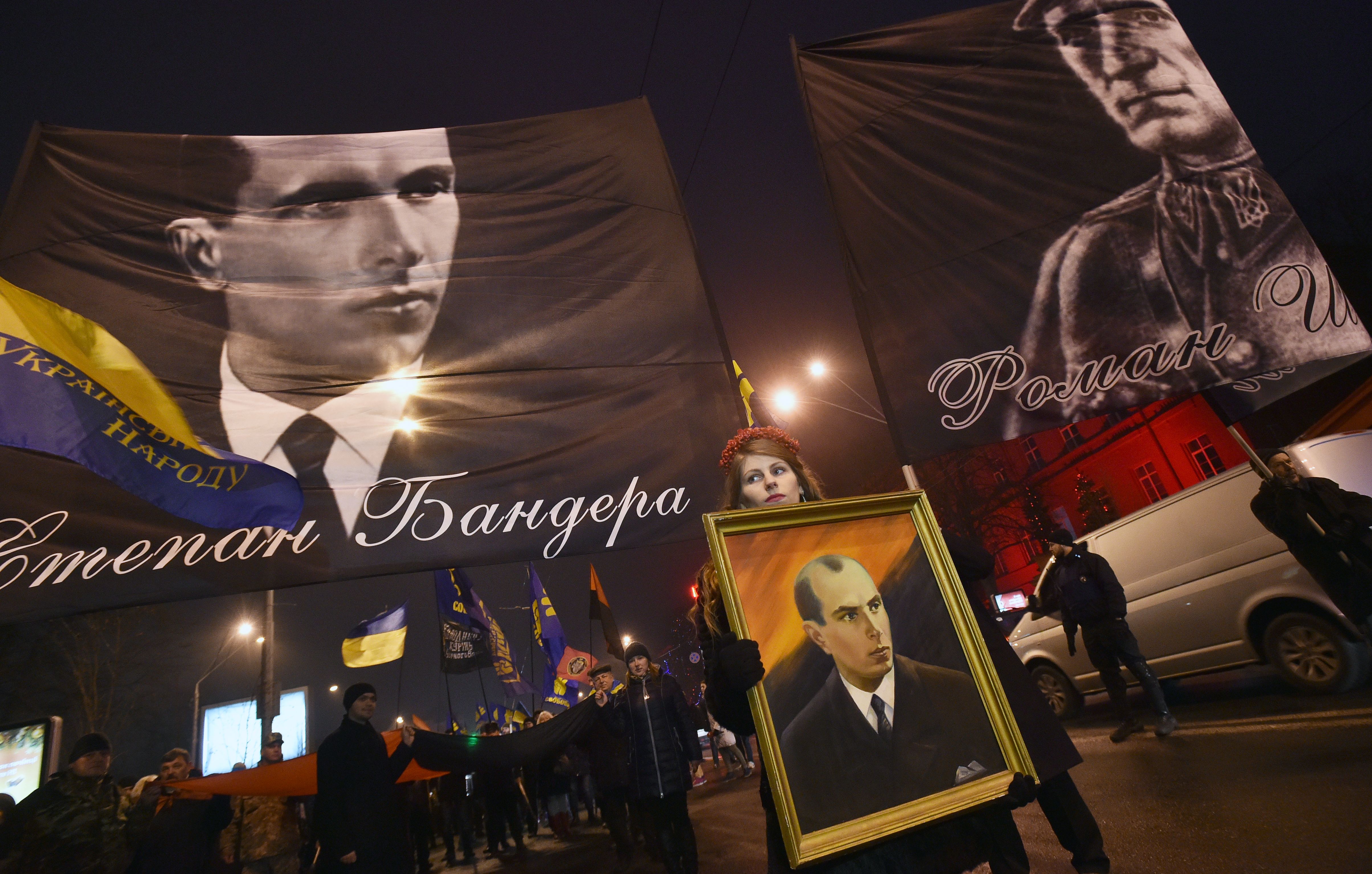
People hold flags picturing Ukrainian politician Stepan Bandera (L), one of the leaders of Ukrainian national movement and leader of the Organisation of Ukrainian Nationalists (OUN) and his ally Roman Shukhevych (R) during a march in Kiev on January 1, 2017, to mark the 108th anniversary of the birth of the Ukrainian politician. (Genya Savilov/AFP/Getty Images)
That narrative of resistance to Russian occupation has become even more relevant following Russia’s annexation of Crimea and its covert invasion of eastern Ukraine, says Arel.
The Soviet Union and then Russia in turn have used the same history to develop a counter-narrative whose purpose was to completely delegitimize the very idea of Ukrainian nationalism and Ukrainian statehood, he says.
“The (Russian) narrative is that Ukrainian nationalists revealed their true faces during WWII, they’re fascists, they’re Nazis, and therefore the very idea of Ukrainian independence is flawed,” says Arel said.
By glorifying the UPA and OUN, Ukrainian nationalists in turn seek to promote a different narrative.
“This is the historic drive to legitimize the aim to become independent from Russia, because what does Russia mean?” says Arel. “Imperial Russia meant banning the Ukrainian language and the Soviet Russia means the Holodomor (genocide by famine), and Soviet Russia in Western Ukraine at the beginning of the war meant the massacre of political prisoners in prisons.”
‘Hero of Ukraine’
Not surprisingly, the campaign to politically rehabilitate and glorify the image of the OUN and UPA and its leaders has not only divided public opinion in Ukraine itself but has also caused serious diplomatic tensions with Poland and Israel.
Warsaw, in particular, had supported Ukraine’s drive to break away from Moscow’s orbit and chart a more pro-Western course ever since the Orange Revolution of 2004.
But in 2007, in a move that continues to poison relations between Kyiv and Warsaw, Ukraine’s pro-Western president Viktor Yushchenko in the best traditions of the Soviet Union bestowed the title of “Hero of Ukraine” to Shukhevych. In 2010 barely a month before the end of his mandate, Yushchenko bestowed the same honour on Bandera.
“Bandera and Shukhevych became sort of front figures in a very clumsy rewriting of history aimed at uniting Ukraine, which at least at that point was quite a divided society, not necessarily between Russian speakers and Ukrainian speakers, but there were definite regional divisions,” says Rudling.
A divisive move
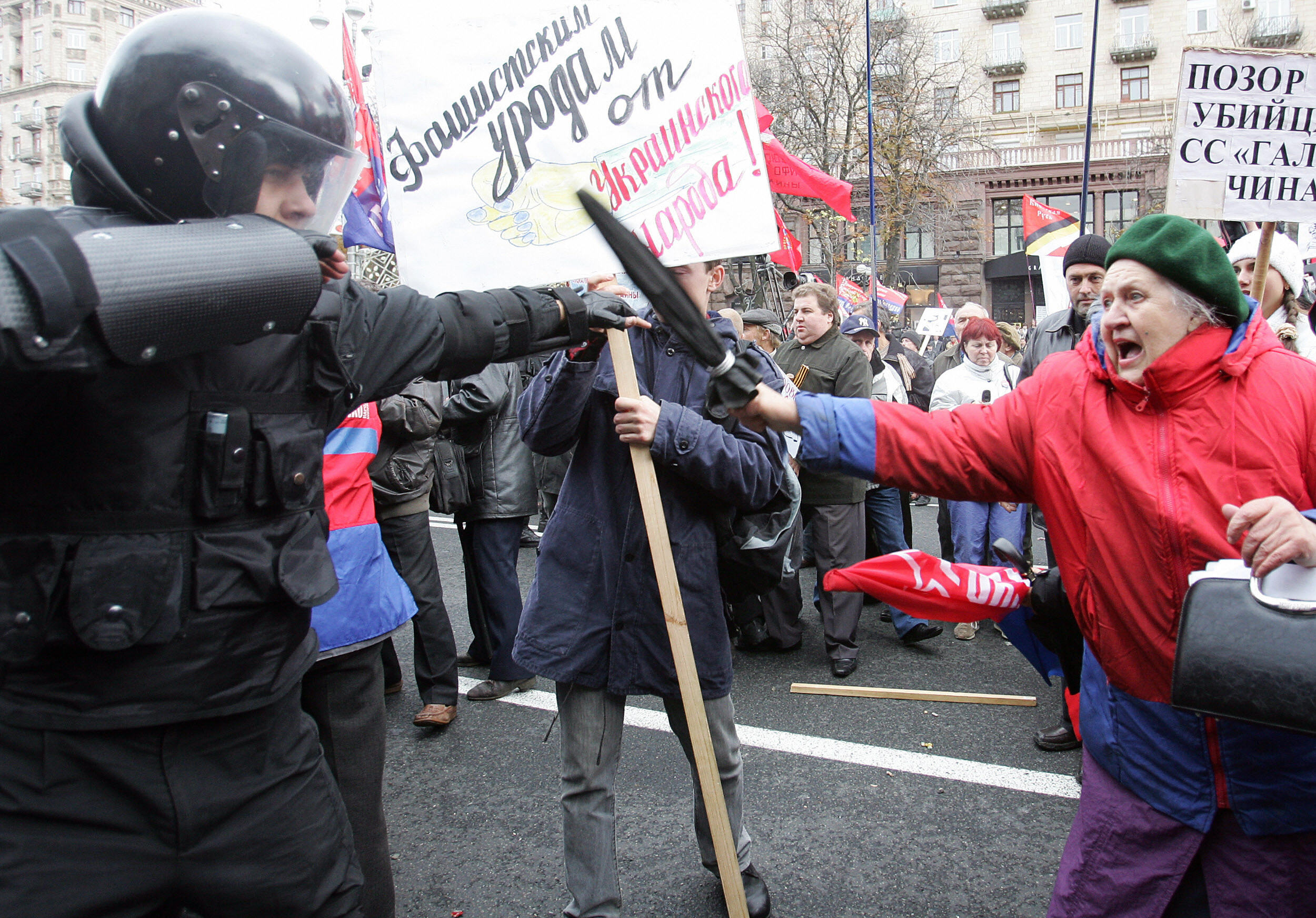
Activists of the ultra-left wing Progressive Socialists party clash with police forces blocking a main street during a protest action in central Kiev 14 October 2007. Police were trying to separate left-wing demonstrators and Ukrainian nationalists marking the 65th anniversary of the founding of a Ukrainian Insurgent Army (UPA), a World War Two guerrilla movement that fought both Nazi invaders and Soviet forces. (Photo credit should read Sergei Supinsky/AFP/Getty Images)
But, the move to rehabilitate Bandera and Shukhevych, which was applauded by many Ukrainian-Canadian organizations and met with silence by Ottawa, did not unite Ukraine, says Ivan Katchanovski, a Ukrainian researcher who teaches at University of Ottawa.
A public opinion survey commissioned by Katchanovski in 2009 showed that just 13 per cent of the respondents expressed positive attitudes towards UPA. However, about 45 per cent of Ukrainians had negative attitudes towards the insurgent army, says Katchanovski.
There were also strong regional differences with most of the support for UPA and OUN based in his native western Ukraine, says Katchanovski.
The strongest backlash against the glorification of the UPA and OUN was in parts of Russian-speaking eastern Ukraine and in Crimea.
And the Russian propaganda, which always sought to downplay Stalin’s own collaboration with Hitler prior to 1941, played up these sentiments to further polarize the country.
Diaspora influence
Many of the displaced Ukrainians who came to Canada after WWII were refugees from Western Ukraine, particularly the Volhyn and Galicia regions, which were the hotbeds of the UPA support.
“So of course that group of people, that generation and their offspring they’ve been raised in this culture,” says Rudling. “They’ve been going to Saturday school, they’ve been performing rituals in front of these monuments, they grew up with this narration of history and to them it’s tradition, culture and I don’t think they didn’t have much reason to reflect upon this.”
Ukrainian intellectuals who were tied to the OUN had a very powerful influence on the life of the community in Canada, says Himka.
“With time all the other tendencies – because there were leftist tendencies, more liberal tendencies – they have pretty much disappeared,” says Himka. “And a lot of the community organizations are headed by the Bandera faction of the Organization of Ukrainian Nationalists.”
It is that part of the community, represented by the Ukrainian Canadian Congress that build the Shukhevych statue in Edmonton and has been pushing for a revisionist view of the OUN’s and UPA’s wartime record, says Himka.
“They have an agenda about their own history,” says Himka. “They want to have a monopoly over what is said about Ukrainian history.”
These Diaspora groups also support the nationalist right in Ukraine and whitewash the WWII history of their movement, says Himka.
“They are very much involved in promoting victimization narratives: the Ukrainian internment during WWI in Canada, the Great Famine (Holodomor) of 1932-33,” says Himka.
“These are the kind of things they really want to drive into the heads of the community so that kids sort of think their grandparents suffered this, although most Ukrainians who came to Canada were not from where the famine was.”
However, the post-war cohort of Ukrainian immigration is a small part of the 1.3 million strong Ukrainian-Canadian community, says Rudling.
“The vast bulk of Ukrainian-Canadians do not really take much interest in Shukhevych and Bandera, and to the extent they do, they probably don’t really reflect much upon this,” Rudling says.
A debate forced by Putin
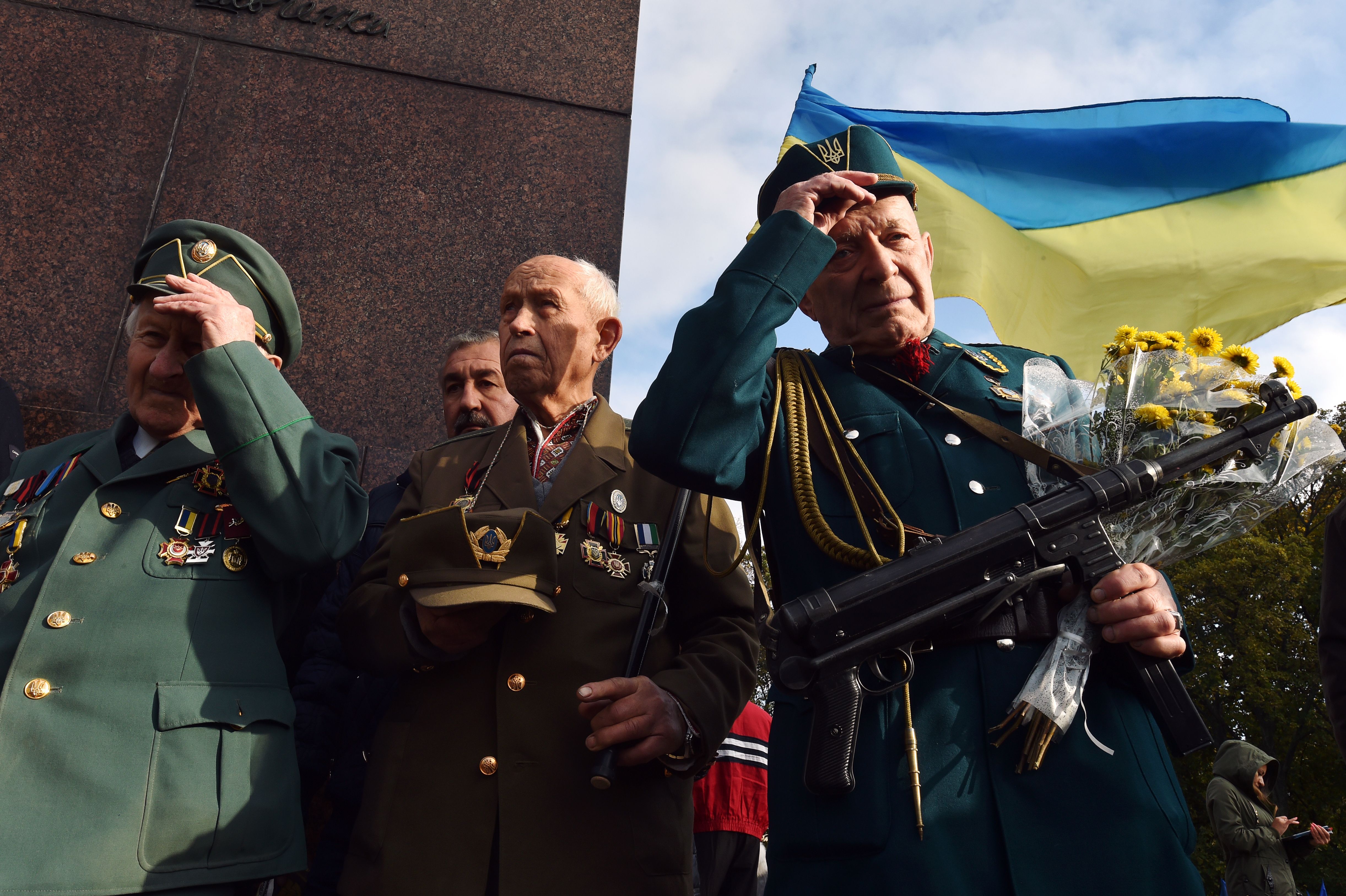
Veterans of the Ukrainian Insurgent Army (UPA) take part in a rally in Kiev on October 14, 2016 to celebrate the Defender of Ukraine Day and the creation of UPA. (Genya Savilov/AFP/Getty Images)
The issue of monuments to Shukhevych or to the 14th Waffen SS Galicia Division in Canada registered barely any interest 10-15 years ago, says Rudling.
“It became an issue now when Russia decides to instrumentalize this, launch a propaganda campaign for political reasons,” says Rudling.
It is quite paradoxical that it was the authoritarian government of President Vladimir Putin that forced this debate in Canada, he says.
“Had this discussion been launched 15 years ago, 10 years ago maybe the Russians wouldn’t have scored a point,” says Rudling.
“Because Russia in this case they are actually right about the historical revisionism taking place, of course, for the wrong reasons. And Russia is itself a society which instrumentalizes (history) very strongly and uses it for political purposes.”
Freedom fighters or Holocaust perpetrators?
The Ukrainian Canadian Congress (UCC) declined Radio Canada International’s request for an interview.
In an emailed statement to RCI, Ihor Michalchyshyn, executive director & CEO of the UCC, said the tweets by the Russian embassy in Canada, which eventually resulted in Ottawa kicking out embassy spokesperson Kirill Kalinin, are part of a concerted campaign to spread falsehoods and incite hatred among ethnic communities in Canada.
“During World War Two Ukrainians were caught between the genocidal regimes of Hitler and Stalin, and fought with valour against both occupiers,” Michalchyshyn wrote.
“The Ukrainian Insurgent Army fought bravely against both the German and Soviet occupiers of Ukraine, well into the 1950s (in the case of the Soviet occupiers). Russia’s campaign to smear these freedom fighters is unsurprising from a regime which is working actively to glorify Stalin, deny the Holodomor as a genocide and praise the crimes of Soviet Russia.”
Himka says attempts to whitewash UPA’s wartime record harm Ukraine’s fledgling democracy by encouraging the far right in Ukraine and negatively impact democratic practices within the Ukrainian community in Canada.
“I think personally that you can’t be making heroes out of Holocaust perpetrators and ethnic cleansers,” says Himka. “I just don’t think that it’s right.”
SS division or a building block for Ukrainian army?
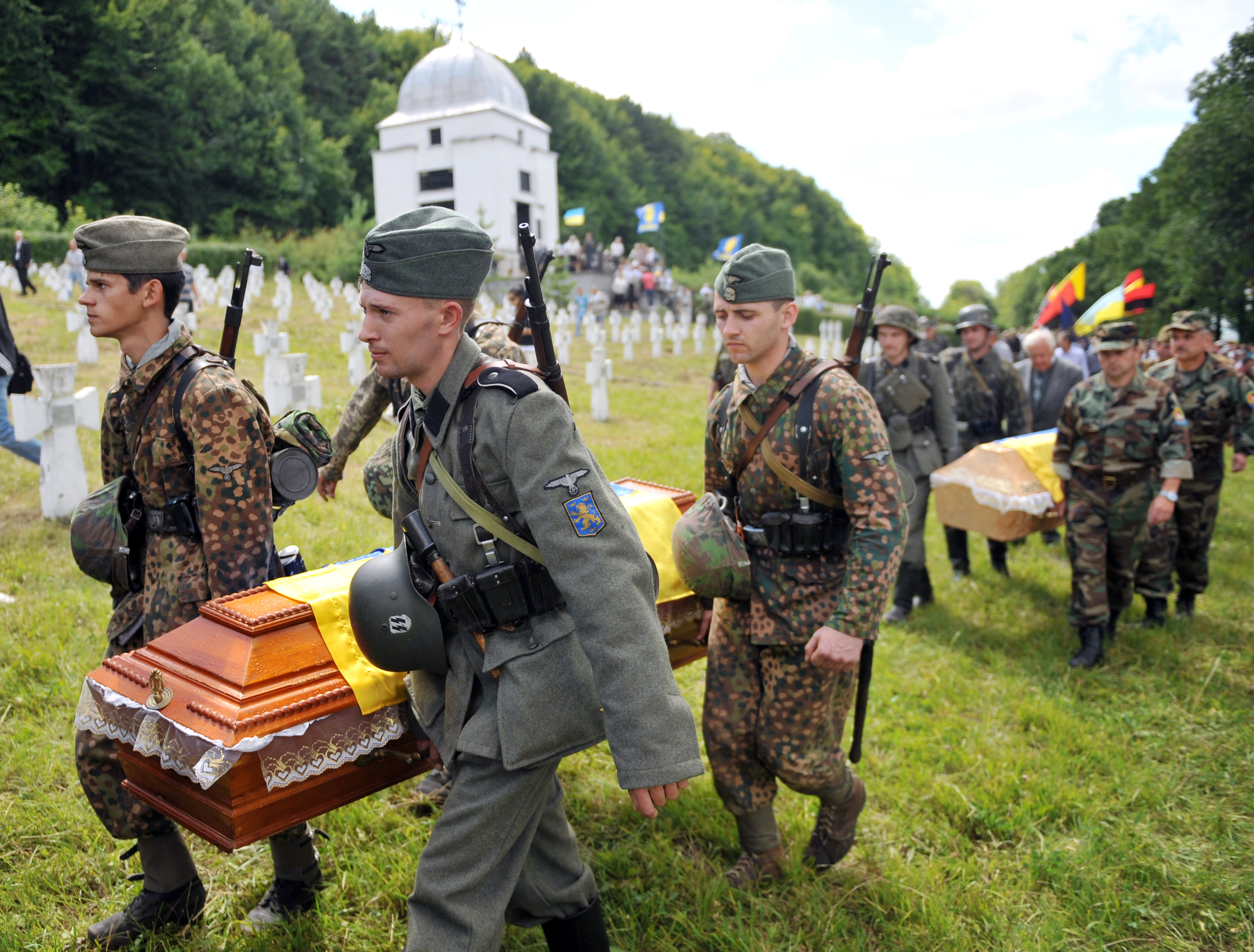
Activists of the Ukrainian Pamiat (Memory) Searching Organization for victims of World War II, carry on July 21, 2013 the coffin with the remains of Soviet and Ukrainian soldiers of the “Galician” SS Division, during a reburial ceremony near the village of Chervone, some 70km west of Lviv. (Yuriy Dyachyshyn/AFP/Getty Images)
Michalchyshyn also reacted to the Russian tweets mentioning the 14th Waffen SS Galicia (Galizien in German) Division, also known as the 1st Ukrainian division.
The veterans of the 14th Division Galicia/Halychyna joined not to fight for Germany, but to fight against Soviet Communist tyranny and for a free Ukraine, says Michalchyshyn.
“Neither the 1st Ukrainian Army, nor the 14th Division ever fought against the Western allies in WWII. Nor did the Ukrainian Insurgent Army,” says Michalchyshyn. “Their burial sites are places for their families to remember and honour them for the sacrifices they made for their families and nation.”
Arel says thousands of Ukrainian nationalists enthusiastically responded to the call to join the Waffen SS division in early 1943.
“It proved widely popular in Western Ukraine because of this overriding idea, historically grounded, that the Ukrainians were never able to succeed because they never had an armed force,” says Arel. “The consensual narrative even from the moderates was that Ukrainians lost everything after WWI because they didn’t have an army and thus they were beaten by the Soviets and by the Poles.”
But because non-Germans weren’t allowed to serve in regular Wehrmacht units, the 11,000 Ukrainian volunteers had no choice but to join one of nearly 40 Waffen divisions in the parallel SS army set up by Germany, says Arel.
(This archive video shows the parade of Ukrainian volunteers of the 14th Waffen SS Galicia Division in spring of 1943 in Lviv)
Even though the Waffen SS divisions were initially set up as guard units for concentration camps, in 1943 the goal of the Galicia division was to fight the Red Army.
Having defeated the Germans in Stalingrad, the Red Army was moving quickly to recapture all of the territory the Soviet Union had lost to Nazi Germany and its allies at the beginning of the war.
The first iteration of the Galicia Division was nearly annihilated by the Red Army at the Battle of Brody in July of 1944.
The unit was reconstituted and moved to Slovakia where it fought against Slovak anti-Nazi resistance and then in Yugoslavia until it surrendered to allied forces in May of 1945.
Canada a heaven for war criminals?
At least 2,000 veterans of the division moved to Canada after WWII from Britain, says Arel.
In 1985, Prime Minister Brian Mulroney launched the Commission of Inquiry on War Criminals in Canada, led by Jules Deschênes, a Justice of the Court of Appeal of Quebec, to investigate claims that Canada had become a haven for Nazi war criminals.
“The veterans of the 14th Division Galicia/Halychyna were cleared of any involvement in war crimes after a long and exhaustive investigation by the Canadian government’s Deschênes Commission, which found, ‘Charges of war crimes against members of the Galicia Division have never been substantiated, neither in 1950 when they were first preferred, nor in 1984 when they were renewed, nor before this Commission,’” says Michalchyshyn.
However, the Deschênes Commission never looked into allegations against the OUN and UPA, says Arel.
“They just had no clue about those guys,” he says.
A vision of an ultra-nationalist state
There is no question that the OUN bears at least political responsibility for the anti-Jewish pogroms in Ukraine with various degree of direct participation in the Holocaust, says Arel.
“To anyone who seriously studies the OUN there is little doubt that there was nothing democratic about the movement,” says Arel. “This was an authoritarian movement whose vision of a Ukrainian independent state would be basically authoritarian state with a single party, an ultra-nationalist state.”
And the first military operation of the UPA was directed not against the Soviets or the German forces but against the Polish population of Volhyn with the aim of ethnically cleansing the region of all Poles, says Arel.
Democratic political memory
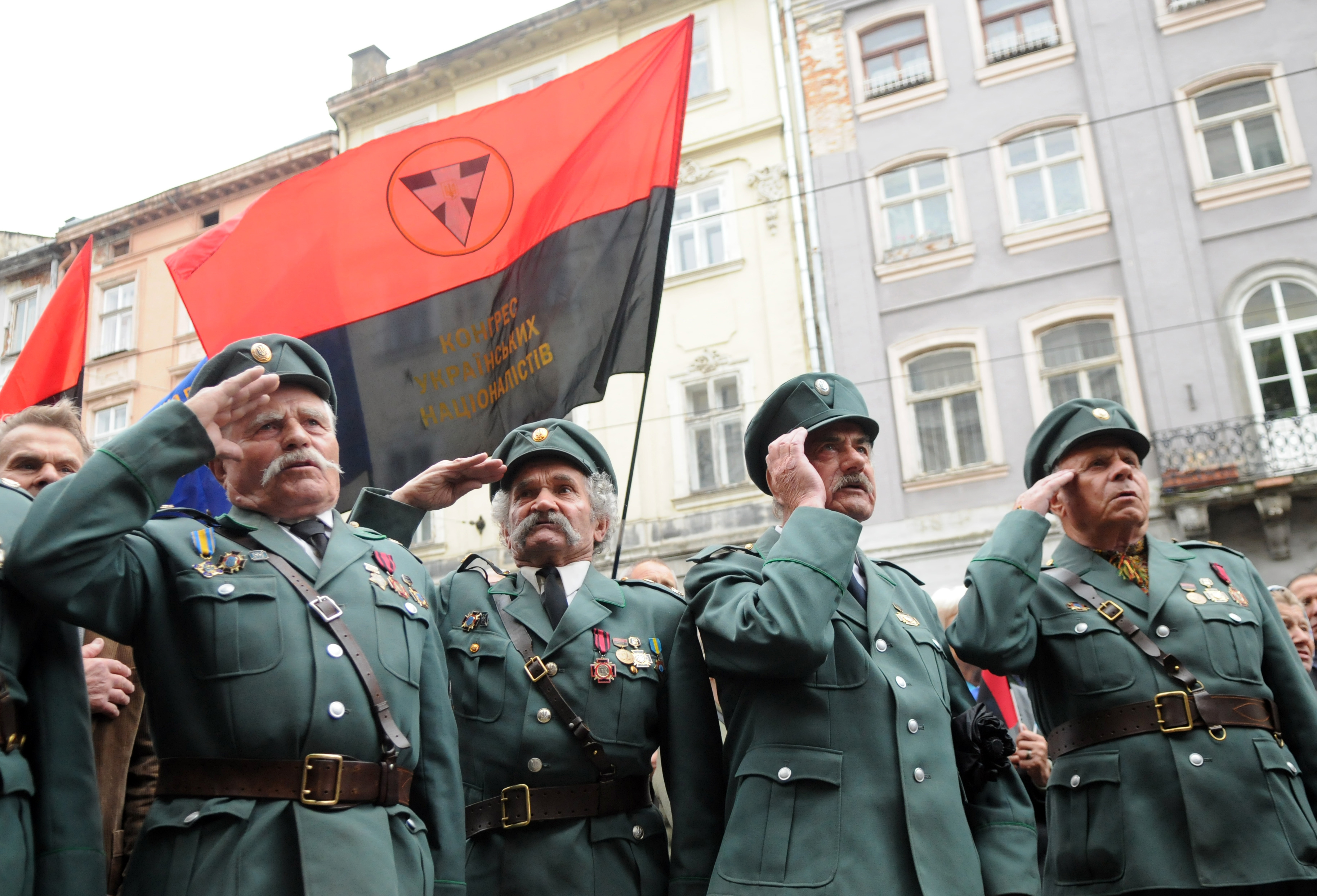
Veterans of Ukrainian Insurgent Army ( or UPA) salute during a cermony marking 103rd anniversary of Roman Shukhevych birthday in Lviv on June 27, 2010. The World War II figure symbolizes the deep divides of the country seeking an identity. (Yuriy Dyachyshyn/AFP/Getty Images)
Arel says the issues of OUN’s and UPA’s troubling wartime record are subject of open scholarly discussions at annual events and conferences organized by the Chair of Ukrainian Studies at University of Ottawa.
There are several young researchers, including those from Ukraine, who specialize in this subject.
“Many of them are fairly critical, critical in the sense that they are for a democratic Ukraine and they are for a democratic political memory,” says Arel.
However, it’s a different matter when it comes to the political landscape in Ukraine and in parts of Ukrainian Diaspora.
“The context in Ukraine is that you have these far right groups,” says Arel. “They are marginal electorally but they are not marginal in terms of the intimidation factor in the public debate and in the streets.”
In the context of the Canadian Ukrainian community there is still a lot of resistance to discussing these painful chapters of Ukrainian history without attempts to whitewash them because of fears that it plays into the hands of the Russian propaganda machine, he says.
“I’ve experienced it myself, there are just things they don’t like us to talk about,” says Arel.
However, there is a slow change of the leadership with younger leaders coming to the forefront, says Arel.
“Hopefully there will be an understanding that you can’t have a democracy if you don’t have a democratic political memory and by that I mean a willingness to hear all kinds of voices, to look at the evidence and to seek to overcome these defensive narratives.”
Canada’s close ties with Ukraine allow Canadian officials to speak frankly about these issues with the Ukrainian government, says Adam Austen, press secretary of Foreign Affairs Minister Chrystia Freeland.
“Minister Freeland has raised them on numerous occasions with officials from Ukraine, including a recent conversation with Prime Minister Volodomyr Groysman, where this was the focus,” says Austen. “She is also in close and frequent contact about these issues with her long-time friend, Yaakov Bleich, the Chief Rabbi of Ukraine.”
Austen says Canada condemns in the strongest terms the glorification of Nazism and all forms of anti-Semitism, racism, racial discrimination, xenophobia, intolerance and extremism.
“Every country must come to grips with difficult periods in their past,” says Austen. “This includes Ukraine.”
